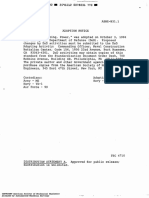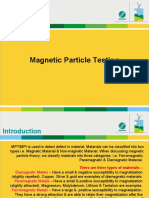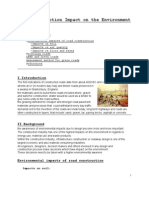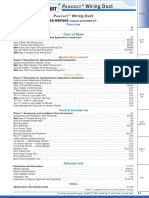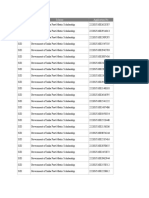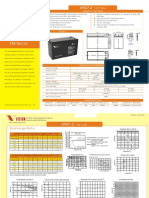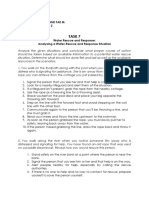Ind-Std Notice T: 1430 Broadway NY 10018
Ind-Std Notice T: 1430 Broadway NY 10018
Uploaded by
lucky kakanCopyright:
Available Formats
Ind-Std Notice T: 1430 Broadway NY 10018
Ind-Std Notice T: 1430 Broadway NY 10018
Uploaded by
lucky kakanOriginal Title
Copyright
Available Formats
Share this document
Did you find this document useful?
Is this content inappropriate?
Copyright:
Available Formats
Ind-Std Notice T: 1430 Broadway NY 10018
Ind-Std Notice T: 1430 Broadway NY 10018
Uploaded by
lucky kakanCopyright:
Available Formats
-
. . . .
c->"L-"
IND-STD ASME BLb.38-85 NOTICE L YB 9999998 0005307 T
I NOTICE OF I ADOPTION NOTICE1
I ADOPTION I 16 September 1991 for
ASME B16.38-1985
July 15, 1986
ASME B16.38-1985 was adoptedon 16 September 1991 and is approved for use by the
Department of Defense (DoD). Both the American Society of Mechanical Engineers
and American National Standards Institute have furnished clearances required by
existing regulations, Copies of this document are stocked at the
Standardization Documents Order Desk, Bldg.4D, 700 Robbins Avenue,
Philadelphia, PA 19111-5094, for issue to DoD activities only, All other
requestors must obtain copies from:
The American Society
of Mechanical Engineers
United Engineering Center
345 East 47th Street
New York,NY 10017
or
American National Standards Institute
1430 Broadway
New York,NY 10018
Title of Doc'ment: Large Metallic Valves for Gas Distribution (Manually
Operated, NPS 2-1/2 to 12, 125 psig Maximum)
Date of Specific Issue Adopted: July15, 1986
Custodian: Military Coordinating Activity:
Navy - M Navy - YD
(Project 4820-0615)
L -
' FSC 4820
COPYRIGHT American Society of Mechanical Engineers
Licensed by Information Handling Services
A AN M E R I C A N A T I O N A SL T A N D A R D
Large Metallic Valves for Gas
Distribution (Manually Operated,
NPS 2l/2 to 12, 1-25psig Maximum)
ANSIIASME B16.38-1985
(REVISION OF ANSI B1 6.38-1978)
SPONSORED A N D PUBLISHED B Y
T H EA M E R I C A NS O C I E T Y OF M E C H A N I C A LE N G I N E E R S
United
Engineering
Center 345 East
47th
Street
New
York, N. Y. 1 O 0 1 7
COPYRIGHT American Society of Mechanical Engineers
Licensed by Information Handling Services
Date of Issuance: July 15, 1986
The 1985 Edition of this Standard is being issued .with an automatic addenda
subscription service. The use of an addenda allows revisionsmade in res.ponset o
public review comments or committee actionsto be published on a regular yearly
basis; revisions published in addenda will become effective 6 months after the
Date of Issuance of theaddenda. The next edition of this Standard is scheduled
for publication in 1988.
ASME issues written replies t o inquiries concerning interpretations of technical
aspects of this Standard. The interpretations will be included with the above
addenda service. Interpretations are not part of theaddenda to theStandard.
This code or standard was developed under procecfures accredited as meeting the criteria for
American NationalStandards. The ConsensusCommittee that approved the code or standard was
balanced to assure that individuals from competent and concerned interests have had an opportunity
to participate. The proposed code or standard was made available for public review and comment
whichprovides an opportunityforadditionalpublicinputfromindustry, academia, regulatory
agencies, and the public-at-large.
ASME does not "approve," "rate," or "endorse" any item, construction, proprietary device, or
activity.
ASME does not take any position with respect to the validity of any patent rights asserted in
connection with any items mentionedin this document, and does not undertake to insure anyone
utilizing a standard againstliability for infringementof any applicableLetters Patent, nor assume any
such liability. Users of acode or standard are expressly advised that determination of the validity of
any such patentrights, andthe risk of infringement of such rights, is entirely theirown responsibility.
Participation by federalagency representative(s)or person(s) affiliatedwith industry is not tobe
interpreted as government or industry endorsement of this code or standard.
ASME accepts responsibility for only those interpretationsissued in accordance with governing
ASMEprocedures and policies which preclude the issuanceofinterpretationsbyindividual
volunteers.
No part of this document may
be reproduced in any form,
in an electronic retrieval systemor otherwise,
without the prior writtenpermission of the publisher.
Copyright O 1986 by
THE AMERICAN SOCIETYOF MECHANICAL ENGINEERS
All Rights Reserved
Printed in U.S.A.
COPYRIGHT American Society of Mechanical Engineers
Licensed by Information Handling Services
FOREW~RD
(This Foreword is not part of ANSVASME B1 6.38-1 985.)
The B16 Standards Committee was organized in the spring of 1920 and held its organiza-
tional meeting on November.21of that year. The group operated as a Sectional Committee
(later redesignated as a Standards Committee) under the authorization of the American
EngineeringStandards Committee [subsequently named American Standards Association,
United Statesof America Standards Institute, and now AmericanNational Standards Insti-
tute (ANSI)]. Sponsors for the group were The American Society of Mechanical Engineers,
Manufacturers Standardization Sdciety ofthe Valve and Fittings Ïndustry, and the Heating
and Piping Contractors National Association (jaterthe Mechanical Contractors Associa-
tion of America). In 1982 the B16 Committee was reorganizedas an ASME Committee
operating under procedures accredited by ANSI.
The American Gas Association determinedthat standardization of gas valves used in
distribution systems wasdesirableandneeded, The A.G.A. Task Committee on Standards
for Valves and Shutoffs was formed and development work commenced 1958. in In 1968 it
was determined that a more acceptable document would result if approvai were gainedfrom
ANSI,and to facilitate such action the A.G.A. Cornmittee became Subcommittee 13 of the
-B16 activity. This B16 group was later renamed Subcommittee L, which is its current
designation.
The first standard developed by the Subcommittee was ANSI B16.33, which was pub-
lished in 1973. As a follow-up, ANSI B16.38 was subsequently developedto cover larger
sues of gas valves and shutoffs, and was first published in 1978.
The present Standard offers more performancerequirements than has been customary in
many B16 standards. It is expected that this will permit both manufacturers and users
greater latitude in producing and üsing products made to this Standard.
Editorial changes were madethroughout the text and tables to bring the formatin line
with the rest of the B16 series Öf standards and to clarify the intent of this Standard. Revi-
sions include changesto the qualification requirements and to requirements for construc-
tion and valve ends, updating of rkferencestandards, and editorial changes to the text and
tables.
The cover, headings, and designation of the standard have also been revisedto reflect
reorganization of the B16 Committee as anASME Committee. This Standard is offered on
a subscriptionservice basisthat includesinterpretations and addenda up to the issuanceof a
new edition.
All requests for interpretations or suggestionsfor revisions shouldbe sent to theAdmin-
istrative Secretary, B16 Committee, The American Society of Mechanical Exigi-neers,
United EngineeringCenter, 345 East 47th Street, New York, N.Y. 10017.
Following approval by the B16 Committee andits ASME Supervisory Board,
. this Standard was approved as an American National Standard by ANSI on Novem-
ber 8, 1985.
iii
COPYRIGHT American Society of Mechanical Engineers
Licensed by Information Handling Services
ASME BLb.38 85 0757b70 OOq2220 O W
ASME B I 6 COMMITTEE
Standardization of Valves, Flanges, Fittings, Gaskets, and Valve Actuators
(The following is the roster of the Committee atofthe
approval
time of thisStandard.)
OFFICERS
W.G. Canham, Chairman
W.N. McLean, Vice Chairman
M.J. Hogan, Secretary
COMMITTEE PERSONNEL
P.H. Awtrey, Walworth Co., Greensburg, Pennsylvania
W. Ballis, ColumbiaGas Distribution Co., Columbus, Ohio
J.E. Batey, Oak RidgeNational Laboratory, Oak Ridge, Tennessee
S.L. Blachman, American Gas Association Laboratories, Cleveland, Ohio
R.R. Brodin, Fischer Controls International,Inc., Marshalltown, Iowa
W.J. Burns, Department of Water and Power, Los Angeles,California
W.G. Canham, Brentwood, Missouri
J.C. Church, Mamaroneck,New York
. A. Cohen,Copper DevelopmentAssociation, Greenwich, Connecticut
J.S. Cole, ITT Grinnell IndustrialPiping, Inc., Kernersville, North Carolina
F.G. Doar, Southern Services, Inc., Birmingham, Alabama
W.C. Farrell, Jr., Stockham Valvesand Fittings, Inc., Birmingham, Alabama
D.R. Frikken, Monsanto Co., St. Louis, Missouri
M.W. Garland, Frick Co., Waynesboro, Pennsylvania
J.C. Inch, Mueller Brass Co., Hartsville, Tennessee
J.S. John, Houston, Texas
W.G. Knecht, Anchor/Darling ValveCo., Williamsport, Pennsylvania
R. Koester, The William Powell Co., Cincinnati, Ohio
J.D. Koski, U.S. Coast Guard, Washington, D.C.
J.E. LeCoff, Elkins Park, Pennsylvania
B.H. Leonard, Atherton, California
J. Longacre, Nibco Inc., Elkhart, Indiana
O.P. Lovett, Newark, Delaware
J.H. McCauley, MGCauley Mechanical, Chicago, Illinois
W.N. McLean, CraneCo., Carol Stream, Illinois
B.J. Milleville, Rockwell International, Pittsburgh,Pennsylvania
A.D. Nalbandian, ITT GrinnellCorp., Providence, RhodeIsland
M.E. O'Hagan, Varve Manufacturers Association,Washington, D.C.
J.A. Osterberg, American Bureau of Shipping, New York, New York
H.W. Palm,Crane Co., St. Louis, Missouri
A.F. Rhodes, Anglo Energy, Ltd., Houston, Texas
R.A. Schmidt, Ladish Co., RusseIlville, Arkansas
T.F. Stroud, Ductile IronPipe Research Association, Birmingham, Alabama
M.R. Suchomel, Underwriters Laboratories Inc., Northbrook, Illinois
R.E. White, Repairs Inc., South Bend, Indiana
D. Wilson, Mobile Pipeline Co., Dallas, Texas
V.F. Wolff, Phillips PetroleumCo., Bartlesville, Oklahoma
COPYRIGHT American Society of t Mechanical Engineers
Licensed by Information Handling Services
PERSONNEL OF SUBCOMMITTEE L ON GAS SHUTOFFS
AND VALVES
S.L.Blachman, Chairman, American Gas Association Laboratories, Cleveland, Ohio
P.D. Stumpf, Secretary, The American Society of Mechanical Engineers, New York, New York
J.E. Allen, Public Service Electric
&Gas Co., Newark, New Jersey
G.L. Anderson, Dresser Industries, Inc., Bradford, Pennsylvania
C.W. Arnott, Brooklyn Union Gas Co., Brooklyn, New York
D.W. Duffy, Rockwell International Corp., Pittsburgh, Pennsylvania
C.E. Floren, Mueller Co., Decatur, Illinois
W.G. Heldbrier, A.Y. McDonald Manufacturing Co., Dubuque, Iowa
C.R. Heseman, Illinois Power Co., Decatur, Illinois
E.E. Moore, Eclipse Inc., Rockford,Illinois
R.B. Pinkston, ConsölidatedNatural Gas Services, Pittsburgh, Pennsylvania
M.A. Robinson, Conbraco Industries, Inc., Matthews, NorthCarolina
E.L. Schmitt, Kerostest Manufacturing Corp., Pittsburgh, Pennsylvania
R.C. Stewart, Worthington, Ohio
F.R. Volgstadt, Perfection Corp., Madison, Ohio
A.G. Yeager, Jr., New Orleans Public Service,Inc., New Orleans, Louisiana
vi
COPYRIGHT American Society of Mechanical Engineers
Licensed by Information Handling Services
ASME B l 1 6 . 3 8 85
CONTENTS
Foreword ................................................................ iii
StandardsCommittee Roster. ............... ..............................
r. v
1 Scope................................................................. 1
2 Construction ..................... .~.................................... 1
3 Qualification Requirements. ............................................. 2
4 ProductionTesting ..................................................... 3
Figure
1 BendTest Assembly .................................................... 5
Tables
1 Duration of Test ....................................................... 2
2 BendingMomentValues. ................................................ 4
3 FlowandHead LossCoefficients ......................................... 4
Annex
A References ............................................................ 6
COPYRIGHT American Society of Mechanical Engineers
Licensed by Information Handling Services
ANSIIASME B16.38-1 985
AN AMERICAN NATIONAL STANDARD
AN AMERICAN NATIONAL STANDARD
LARGE METALLIC VALVESFOR GAS DISTRIBUTION
(MANUALLY OPERATED, NPS 2'12 TO 12,125 psig MAXIMUM)
1 SCOPE 2 CONSTRUCTION
1.1 Valve Types 2.1 General
This Standard covers only manually operated me- (u) Each completed and assembled valve shall be
tallic valves in nominal pipe sizes 2% through 12 capable of meeting the requirements setforth in this
having the inlet and outlet.on a common center line, Standard. The workmanship employedin the manu-
which are suitable for controllingthe flow of gasfrom facture and assembly of each valveshall provide gas
open to fully closed,for use indistribution and service tightness, safety and reliability of performance, and
lines wherethe maximum gagepressure at which such freedom from injurious imperfections and defects.
distribution piping systems may be operated in ac- (b) Minimum levels of performance, quality, and
cordance with theCode of Federal Regulations materials of valves used shall be those described inone
(CFR), Title 49, Part 192, Transportation of Natural or more of the following standards and specifications
andOther Gas by Pipeline;MinimumSafety or the equivalent' for pressure-temperature ratings
Standard, does not .exceed 125 psi (8.6 bar). Valve Class 125 or 150: MSS SP-67, MSS SP-70, MSS
seats, seals, and stem packing may be nonmetallic. SP-72, MSS SP-78, MSS SP-80, MSS SP-84, and
ANSI B16.34 (see Annex A).
(c) AU materials including lubricants that are ex-
posed to gas shall be resistant to the action of the gases
1.2 Application referred to in para. 1.2 or to the specific gas specified
This Standard sets forth the minimum capabilities, by the purchaser.
characteristics, -and properties which a newly manu-
factured metallic valve must possess in order to be 2.2 Tamperproof Features
considered suitable for use in piping systems indicated
above with natural gas, manufactured gas [includes Where valvesare specified to be tamperproof, they
syntheticnatural gas (SNG)],and liquefied petroleum shall have features which minimizethe possibility of
gases (distributedas a vapor, with or without the ad- disassembly of pressure-containing parts with other
mixtureof air) or mixtures thereof. (Nonmetallic than specialized tools.
components, such as elastomer seals or sealants, may
be adversely affected by gases having high hydrogen
content or compounds likely to form condensates. 2.3 Configuration
Specific application details must be considered.) De- 2.3.1 Operating Indication
tails of designand manufacture, including designand (u) Valves designedfor one-quarter turn operation
production tests other than those stated in this Stand- shall be designedto visually showthe open and closed
ard, remain the responsibility of the manufacturer. position of the valve. A rectangular stem head or a
position indicator shall indicate the closed positionof
the valve port when the longitudinal axis of the stem
head or indicator is perpendicular to the axis of the
1.3 Referenced Standards
Standards and specifications referenced under this 'The word equivalent is used in the sense of providing equivalent
Standard are shown in Annex A. safety.
1
COPYRIGHT American Society of Mechanical Engineers
Licensed by Information Handling Services
ASME 8 1 6 . 3 8 85 0757630 0042224 8 H
ANSUASME B16.38-1985
AN AMERICAN NATIONAL STANDARD LARGE METALLIC VALVESFOR GAS DISTRIBUTION
connecting pipe. If a separate indicator is employed,it
shall be designed suchthat itcannot be assembledto
TABLE 1
Valve Size,
DURATION OF TEST
Minimum Duration,
O
incorrectly indicate the position of the valve. NPS min
(b) Valves shall close by clockwise stem rotation
2‘12 - 5 2
unless otherwise specified by the purchase order. The 6 -10 5
direction for closing the valve shall be indicated. 12 10
2.3.2 Valve Ends. Valve ends shallconform to the
following standards where applicable: ANSVASME
B1.20.1, ANSI B16.1, ANSI B16.5, ANSI B16.11, If the sizes regularlymanufactured do not span the
ANSI B16.25, and ANSI B16.34 (see Annex A). ranges shown, then the largest size manufactured in
each range shall be tested.
2.3.3 Dimensions. Face-to-face and end-to-end
Valveswhich require pressure lubricating as de-
dimensions of valves (other than ball, butterfly, or
scribed inpara. 2.5 may not be relubricatedduring the
diaphragm valves) with flanged ends or buttwelding qualificationtests.
endsshall conform to the requirements of ANSI
B16.10. Face-to-face and end-to-end dimensions of
or buttwelding ends shall
ball valves with flanged ends 3.2 Number of Tests
conform to the dimensions containedin MSS SP-72. Qualification tests need only be conducted on an
Face-to-face dimensionsfor butterfly valves shall be
initial basis provided no material or design changes
in accordance withthe dimensions contained inMSS havebeenmadewhichcouldadversely affect the
SP-67. results of any qualification test results, and provided
the valve was manufactured under a quality control
2.4 Marking system which provides assurance that each item manu-
factured is of comparable quality and capable of per-
Each valve,in addition to the markings requiredby formances essentially equivalentto that of the tested
MSS SP-25, shall bearthe designation “B16.38” and
“T” for tamperproof construction where tamper-
proof featuresare included but are not easily identifi-
unit. Otherwise the necessary qualification tests must
be repeated.
All pressures specified in the following tests are
a
able without disassembling the valve. The marking
gage pressures. 1
“T” may beshown on the operating heador stem.
3.3 Gas Tightness
2.5 Lubrication (Sealant)
A valve shall providea shutoff when in the closed
Valves whichrequire pressure lubrication (by the in- position and shall not leak to the atmosphere in the
jection of sealant through fittings to the sealing sur-
open, intermediate, or closed position.
faces of the valve) shall be capable of being lubricated I
in both the full-open and the full-closed position while 3.3.1 Method of Test forGas Tightness L
subject to an inlet gage pressure of 125 psi (8.6 bar). (a) Shell Test. With the valve inthe open or parti-
ally open position and the outlet capped, air or gas
pressures of first 4 & 2 psi (0.3 f O.13 bar) and then
188 psi (13 bar) shall be appliedto the inlet of the valve
with the valve immersed ainbath of water at a temper-
3 QUALIFICATION REQUIREMENTS ature of 74 f 15 “F(23 & 8 “C).Leakage (as evidenced
3.1 QualificationTests by the breaking away of bubbles) shall not be per-
mitted. The minimum duration of each portion of the
In a range of sizes of valves which the
usesame ma- test shall be as specifiedin Table l .
terials and are proportionally designed, qualification (b) Seat Test. Following the shell test, and after
tests consisting of tests
for gas tightness,temperature removing the outlet cap, with the valve in the full-
resistance, bending, and flow capacity shall be con- closed position, air or gas pressures of first 4 f 2 psi
ducted onat least one sample of one of the two largest (0.3 -+ O. 13 bar) and then 188 psi (13 bar) shall beap-
sizes inthe following ranges:
Range #1- NPS 5 and smaller valves
Range #2 -NPS 6 to 12 valves
plied to one end of the valve withthe valve immersed
in a bath of water at a temperature of 74 f 15 “F
(23 +. 8 “C).Leakage (as evidenced by the breaking
@i
2
COPYRIGHT American Society of Mechanical Engineers
Licensed by Information Handling Services i
ASME 616-38 B 5 W 0 7 5 7 6 7 0 0 0 4 2 2 2 5 T m
ANSVASME B16.38-1985
LARGE METALLICVALVES FOR GAS DISTRIBUTION AN AMERICAN NATIONAL STANDARD
away of bubbles)shall not be permitted overthe time (I) FOIductile materials:
periods specified in Table 1. The test pressures shall
Actual YieId Strength of Body Material
then be appliedto the other valve end underthe same
Specified Minimum Yield Strengthof Body Material
test conditions and acceptance criteria.
(2) For nonductile materials:
Actual Tensile Strength of Body Material
Specified Minimum Tensile Sfrength of Body Material
3.4 CoqtinuedOperation
Strength values shall be determined in accordance
A valve shall providea shutoff as determinedor as with the appropriate material specification.
outlined in para, 3.3 after having been operated for (b) Two bending testsshall be conducted, one with
ten cycles betweenthe limits of full closed to full open the load applied parallelto the valve stemand one with
and back to full closed when subjectedto an internal it applied perpendicularto the valve stem.The valve
air or gas pressure of 125 psi (8.6bar) with the outlet shall be in the half-open position and pressurized in-
capped. ternally to a pressure of 125 psi (8.6bar) for theperiod
of time indicated in Table 1 with no visible leakageto
the atmosphere. The cover (from whichprotrudes the
stem or equivalent) shall be placed in tension when
3.5 Temperature Resistance loaded in the parallel-to-the-stem position. While sub-
A valve shall be operable at metal temperatures jected to these moments, the valve shall operate
rangingfrom -20°F (-29°C) to 150°F (66°C) with- through a fulI cycle of opening and closing. The test
out affecting the capability of the valve to control the fixture shall apply an essentially uniform bending load
flow of gas and without leakage to the atmosphere. with zero shear load (neglecting fixture pipe and valve
weight)throughout the valve length as provided by the
3.5.1 Method of Test arrangement in Fig. l.
(a) The valve shall be maintainedat a temperature (c) After the bending load is removed, there shall
of - 20 "F(- 29 "C) for a period long enough to allow be no permanent deformation that would render the
all parts to come to equilibrium temperature. With the valve inoperable or cause it to leak to the atmosphere
valve subjected to an internalairor gas pressure 125 of when tested as specified in para. 3.3. l.
psi (8.6bar) and the outlet side sealed,it shall be deter-
mined that it can be opened and closed in a normal
manner.
(b) The valve shall then be maintainedat a temper- 3.7 Flow Capacity
ature of 150"F (66 "C)for a period long enoughto al- The shape, size, and configuration of the flow pas-
lowall parts to come to equilibrium temperature. sage in fully open valves shall be designed to provide
With the valve subjectedto aninternal air or gas pres- flow and head loss coefficients specifiedin Table 3.
sure of 125 psi (8.6bar) and the outlet sealed, it shall Qualification tests shall be conducted usinga techni-
be determined that it can be opened and closed in a cally competent procedure such as that contained in
normal manner. ANSIIISA SP-75.02. The test fluid and the type of
(c) The valve shall then be allowed to return to a test facility and instrumentation are at the discretion
temperature of 74 f 15"F(23 f 8 "C)and subjected to of the manufacturer and shall be fully describedin his
the test outlined in para. 3.3. records.
3.6 Structural Provisions - Bending
4 PRODUCTION TESTING
A valve shall withstand the bending test specified Gas tightness ofproduction valves shall be demon-
below. strated by subjecting eachvalve to first a shell test and
3.6.1 Method of Test for Bending then a seat test using airor gas pressureto at least 188
(a) A valve shall withstand without harmful effects psi (13 bar). Leakage (as evidenced by the breaking
the bending moment specifiedin Table 2 adjusted by away of bubbles) shall not be permitted over a time
the appropriate ratio in (1) or (2) below. period of at least 15 sec.
3
I -~
COPYRIGHT American Society of Mechanical Engineers
Licensed by Information Handling Services
ANSIIASME B16.38-1985
AN AMERICAN NATIONAL STANDARD LARGE METALLIC VALVESFOR GAS DISTRIBUTION
TABLE 2 BENDING MOMENT VALUES'
Thickness
Test Bending
Wall Moment
Nominal Pipe
Size [Note (211 Ibf-in. N.m In. mm
2112 3 1,000 3 500 4.78 O. 188
3 44,000 4 975 0.188 4.78
3112 59,000 6 675 4.78 O. 188
4 8 475 4.78 O. 188
1 5 13 100 O. 188 4.78
6 18 525 4.78 0.188
8 335,000 37 850 0.219 5.56
10 51 2,000 57 850 0.219 5.56
12 91 750 0.250 6.35
NOTES:
(1) Values arecalculated bending moments using 35,000 SMYS
psi steel pipewith wallthicknesses shownin theTable.
(2) For valveshaving differentsize inlet and outlet, the smaller sizeshall determinethe bendingvalue.
TABLE 3 FLOW AND HEAD LOSS COEFFICIENTS
Alternate Coefficients
Minimum
Gas Flow Equivalent Length
at Reference of Standard Weight
Nominal Conditions Valve Head Loss in Pipe or Schedule 40 Pipe,
Valve [Note (211 Coefficient Velocity Heads Max.
Size C,,. Min. K. Max.
[Note (111 m3/h ft3/hr [Note (311 [Note (411 ft m
_-___-
2112 125 4,400 150 1.5 17 5.2
3 6,000 170 200 2.0 30 9.1
3% 8,000 227 270 2.0 35 10.7
4 9,900 280 330 2.1 43 13.1
5 425 15,000 490 2.4 65 19.8
19,000 6 538 630 3.0 1O0 30.5
30,000 8 850 990 3.7 180 54.9
47,000 10 1330 1560 3.7 230 70.1
66,000 12 1870 2200 3.7 280 85.3
NOTES:
(1) For valveshaving differentsize inlet and outlet, the smaller sizeshall determinethe coefficient.
(2) Minimum gas flow instandard cubic feetper hour (cubic meters per hour) withthe valve in the fully open position atan inlet gage
pressure of 0.5psi (0.035 bar), 70°F (21.I OC), 0.64 specific gravity, and 0.3in. (7.6 mm) water column net valve pressure drop,
assuming valve in Schedule 40 pipe.
(3) C, = flow of water at 6OoF (16OC) in U.S. gallons perminute which a valve will pass at a pressure drop of 1.Opsi (0.07 bar).
(4) K = head loss coefficient consistentwith theequation:
h, = K ($)
where
hl = head loss produced byvalve, ft (m)
V = fluid velocityin pipe, ftlsec (mls)
g = acceleration due to gravity, ftlsec' (mis')
COPYRIGHT American Society of Mechanical Engineers
Licensed by Information Handling Services
ANSVASME B1 6.38-1985
LARGE METALLIC VALVESFOR GAS DISTRIBUTION AN AMERICAN NATIONAL STANDARD
R R
A = load application yoke
B = connecting pipe, Schedule80 of a size to match
the valve nominal size
F = applied load
R = reaction force = F / 2
S = distance from valve center line to reaction point
Y = distance from valve center tine to the applied load
Formula for Bending Moment M6
F
Mb = - ( S - Y)
2
FIG. 1 BEND TESTASSEMBLY
COPYRIGHT American Society of Mechanical Engineers
Licensed by Information Handling Services
ASME B L b . 3 8 8 5 M 0759b70 0 0 4 2 2 2 8 5 m
ANSVASME B16.38-1 985
AN AMERICAN NATIONAL STANDARD LARGE METALLIC VALVESFOR GAS DISTRIBUTION
ANNEX A
REFERENCES
(This Annex is an integral partof ANSVASME 816.38-1985 and is placed after the maintext for convenience.)
The following is a list of standards and specifications referenced in
this Standard, show-
ing the year of approval.
ASME Publications (Approved as American National Standards)
ANWASME B1.20.1-1983 Pipe Threads, General Purpose (Inch)
ANSI B16.1-1975 Cast Iron Pipe Flanges and Flanged Fittings, Class 25,
125,250 and 800
ANSI B16.5-1981 Pipe Flanges and Flanged Fittings
ANSI B16.10-1973 Face-to-Face and End-to-End Dimensions of Ferrous
Valves
ANSI B16.11-1980 Forged SteelFittings, Socket-Welding and Threaded
ANSI B16.25-1979 Buttwelding Ends
ANSI B16.34-1981 Valves - Flanged and Buttwelding End
ISA Publications
ANSIASA SP-75.02-1982' Standard Control Valve Capacity TestProcedure
MSS Publications
MSS SP-25-1978(R1983) Standard Marking System for Valves, Fittings, Flanges
and Unions
MSS SP-67-1976 Butterfly Valves
MSS SP-70-1976 Cast Iron Gate Valves, Flanged and Threaded Ends
MSS SP-72-1970 Ball Valves with Flangedor Butt-welding Ends for Gen-
eral Service
MSS SP-78-1977 Cast Iron Plug Valves, Flanged and Threaded Ends
MSS SP-80-1974 Bronze Gate, Globe, Angle and Check Valves
MSS SP-84-1978 Steel Valves, Socket Weldingand Threaded Ends
'The ISA approval date for SP-75.02is 1981.
COPYRIGHT American Society of Mechanical Engineers
Licensed by Information Handling Services
ASME BL6.3B B5 W 0757bJO 0042227 7 W
ANSVASME B16.38-1985
LARGE METALLIC VALVES FOR
DISTRIBUTION
GAS
AMERICAN
AN
NATIONAL
STANDARD
Publications of the following organizationsappear on the above list:
ASME The American
Society of Mechanical
Engineers
345 East 47th Street
New York, NY 10017-
ASME Order Department
22 Law Drive
Box 2300
Fairfield, NJ 07007-2300
ISA Instrument Society of America
67 Alexander Drive
P.O. Box 12277
Research Triangle Park, NC 27709
MSS Manufacturers Standardization Society ofthe Valve and
Fittings Industry
1-27Park Street, N.E.
Vienna, VA 22180
Publications appearing above which have been approved as American National Stan-
dards may also be obtained from:
American
ANSI National Standards Institute
1430 Broadway
New York, NY 10018
COPYRIGHT American Society of Mechanical Engineers
Licensed by Information Handling Services
AMERICANNATIONALSTANDARDS FOR PIPING.
PIPE FLANGES.FITTINGS.ANDVALVES
Scheme for the Identification of Piping Systems ................. ..................................... A I 3.1-1 981( R I 985)
:
Pipe Threads - General Purpose (Inch) ..................................................................... B I .20. 1.1983
Dryseal Pipe Threads (Inch) ........................................................................ B I .20. 3.1976(R1 982)
Cast Iron Pipe Flanges and Flanged Fittings, Class 25, 125, 250 and 800 ........................................ B I 6.1-1975
Malleable Iron Threaded Fittings. Class 150 and 300 ............................................................ B I 6.3-1 977
Cast Iron Threaded Fittings. Classes 125 and 250 ............................................................. B16.4-1985
Factory-Made Wrought Steel Buttwelding Fittings
.
PipeFlangesandFlanged Fittings . . . . . . . . . . . . . . . . . . . . . . . . . . . . . . . . . . . . . . . . . . . . . . . . . . . . . . . . . . . . . . . . . . . . . . . . . . . B 1 6 .
............................................................. B I 6.9-1 978
5.1981
Face-to-Face and End-to-End Dimensions of Ferrous Valves .................................................. .BI 6.10-1 973
Forged Steel Fittings. Socket-Welding andThreaded .......................................................... B I6.1 1-1 980
Cast Iron Threaded Drainage Fittings ....................................................................... . B I 6.12-1 983
Ferrous Pipe Plugs. Bushings. and Locknuts with Pipe Threads ................................................. .BI 6.14-1983
Cast Bronze Threaded Fittings. Class 125 and 250 .......................................................... . B I 6.1 5-1978
Cast Copper Alloy Solder Joint Pressure Fittings ............................................................. .BI 6.18-1 984
Ring-Joint Gaskets and Grooves for Steel Pipe Flanges ....................................................... . B I 6.20-1 973
Nonmetallic Flat Gaskets for Pipe Flanges ................................................................... . B I 6.2b19.78
Wrought Copper and Copper Alloy Solder Joint Pressure Fittings .............................................. . B I 6.22-1 980
Cast Copper Alloy Solder Joint Drainage Fittings - DWV ..................................................... . B I 6.23-1 984
Bronze Pipe Flangesand Flanged Fittings. Class 15 0 and 3 0 0 .................................................. B I 6.24-1979
Buttwelding Ends . .........................................................................................B16.2 5.1979
Cast Copper Alloy Fittings for Flared Copper Tubes ........................................................... B I 6.26-1 983
Wrought Steel Buttwelding Short Radius Elbows and Returns ................................................. . B I 6.28-1 978
Wrought Copper and WroughtCopper Alloy Solder Joint Drainage Fittings - DWV .............................. B16.29-1980
Cast Copper Alloy Solder Joint Fittings forSovent@Drainage Systems ......................................... B16.32-1984
Manually Operated Metallic Gas Valves for Use in Gas Piping Systems Up to 125psig (Sizes % Through 2) ........B16.33-1 981
Valves - Flanged and
Buttwelding End ..................................................................... . B I 6.34-1 981
Steel Orifice Flanges, Class 300. 600, 900, 1500 and 2500 Including 1979 Addenda - Class 400 .............. B I 6.36-1 975
Testing Hydrostatic
Control of Valves ...................................................................... . B I 6.37-1 980
Large Metallic Valvesfor Gas Distribution (Manually Operated. NPS 2 % t o12. 125 psig Maximum) ............... B I 6.38-1 985
Malleable Iron Threaded Pipe Unions. Class 150. 250 and 300 ................................................ . B I 6.39-1 977
Manually Operated Thermoplastic Gas Shutoffs and Valves in Gas Distribution Systems ........................ . B I 6.40-1 985
Ductile Iron Pipe Flanges and Flanged Fittings. Class 1 5 0 and 300 ............................................ .BI 6.42-1 979
Wrought Copper and Copper Alloy Solder Joint Fittings for Sovent@ DrainageSystems ......................... .B16.4 3.1982
Power Piping ............................................................................................... B31 .1.1983
Fuel Gas Piping ............................................................................................. B31.2-1968
Chemical
Refinery
Plant and Petroleum Piping ................................................................. B31.3-1984
Liquid Petroleum Transportation Piping Systems ............................................................... B31.4-1979
Refrigeration Piping .......................................................................................... B31.5-1983
Transmission Gas and Distribution Piping Systems .............................................................
B31.8-1982
Building Services Piping ..................................................................................... B31.9-1982
ASME Guide for Gas Transmission and Distribution Piping Systems - 1983 (notan ANSI Standard) ...........................
.
Corrosion Control for ANSI B31 1 Power Piping Systems (not anANSI Standard) .............................................
and Welded Steel Wrought Pipe ..................................................................
B36.10M-1985
Stainless Steel Pipe ...................................................................................... B36.19M-1985
Self-operated and Power-Operated Safety-Related Valves Functional Specification Standard .............
N278.1-1975(R1984)
The ASME Publications Catalog showsa complete list of all the Standards published by the Society.
The catalog and binders for holding these Standards are available upon request.
J05585
COPYRIGHT American Society of Mechanical Engineers
Licensed by Information Handling Services
You might also like
- Asme B94.6-1984 (2014)Document24 pagesAsme B94.6-1984 (2014)Sevuga Rajan50% (2)
- CloudFoundations - 04 - AWS Cloud SecurityDocument54 pagesCloudFoundations - 04 - AWS Cloud SecurityJan jan1100% (2)
- Asme B1.21M-1997 (2018)Document68 pagesAsme B1.21M-1997 (2018)Md. Firozur RahmanNo ratings yet
- Final Bill PDFDocument13 pagesFinal Bill PDFAnonymous GJ3U0l0% (1)
- Asme 19.2 1987Document145 pagesAsme 19.2 1987Popescu Alin100% (4)
- Asme B31.9Document86 pagesAsme B31.9mrivera100% (6)
- ASME B1.16 - B1.16M - 1984 (Reaffirmed 2006) PDFDocument184 pagesASME B1.16 - B1.16M - 1984 (Reaffirmed 2006) PDFKristin Jones100% (2)
- Asme B1.20.1 - 1983Document59 pagesAsme B1.20.1 - 1983kkobaseNo ratings yet
- Ansi 1.8 PDFDocument42 pagesAnsi 1.8 PDFSantiago GarciaNo ratings yet
- Asme B16.21Document21 pagesAsme B16.21Anant RubadeNo ratings yet
- Asme B16.15-1985 PDFDocument37 pagesAsme B16.15-1985 PDFRuben Dario Mamani ArellanoNo ratings yet
- ASME PTC 30 For Air CoolerDocument91 pagesASME PTC 30 For Air CoolerRama KrishnanNo ratings yet
- Ultrasonic Welding of Lithium-Ion Batteries: Enter asset subtitleFrom EverandUltrasonic Welding of Lithium-Ion Batteries: Enter asset subtitleNo ratings yet
- Licensed by Information Handling Services Licensed by Information Handling ServicesDocument147 pagesLicensed by Information Handling Services Licensed by Information Handling Servicesrogel_ganaNo ratings yet
- Asme B1.7M PDFDocument27 pagesAsme B1.7M PDFjojeecares0% (1)
- Textura de Las Superficies ANSI B34.1 NGELDocument48 pagesTextura de Las Superficies ANSI B34.1 NGELPedro PerezNo ratings yet
- B01 16M PDFDocument174 pagesB01 16M PDFziedNo ratings yet
- Asme B16.38 - 1985Document15 pagesAsme B16.38 - 1985amrandconanNo ratings yet
- ML 031470592Document198 pagesML 031470592andyNo ratings yet
- Licensed by Information Handling Services Licensed by Information Handling ServicesDocument20 pagesLicensed by Information Handling Services Licensed by Information Handling ServicesAnonymous AA30q4100% (1)
- Asme b1.20.1Document31 pagesAsme b1.20.1T KANNANNo ratings yet
- Ansi A112.21.3m 1985Document16 pagesAnsi A112.21.3m 1985Marco VeraNo ratings yet
- Ansi B1.20.7Document24 pagesAnsi B1.20.7gxbxb100% (2)
- Asme B16.18 PDFDocument45 pagesAsme B16.18 PDFRuben Dario Mamani ArellanoNo ratings yet
- Ansi Asme B1 2 1983Document190 pagesAnsi Asme B1 2 1983Beckham TopElevenNo ratings yet
- ASME 3977-2-2000 Gas Turbines - STD RefDocument13 pagesASME 3977-2-2000 Gas Turbines - STD Refibson045001256100% (3)
- b16.36 Orifice FlangesDocument27 pagesb16.36 Orifice Flangesali kajbafNo ratings yet
- b16 21 PDFDocument21 pagesb16 21 PDFavinash_k007No ratings yet
- Asme B16.26 PDFDocument13 pagesAsme B16.26 PDFRuben Dario Mamani Arellano100% (1)
- PTC40Document70 pagesPTC40abdelkaderNo ratings yet
- Asme B16.45 (1998)Document19 pagesAsme B16.45 (1998)Augusto ManuelNo ratings yet
- Asme Ansi 16.11 Accesorios PDFDocument27 pagesAsme Ansi 16.11 Accesorios PDFMiguel Urzagaste CruzNo ratings yet
- Asme b18.2.26 (1996) - Fasteners For Use in Structural AppllcatlonsDocument23 pagesAsme b18.2.26 (1996) - Fasteners For Use in Structural Appllcatlonsgusla7No ratings yet
- ASME 16.21 Nonmetalic GasketDocument21 pagesASME 16.21 Nonmetalic Gasketrc galinatoNo ratings yet
- ANSI B16 5 Bridas y AccesoriosDocument157 pagesANSI B16 5 Bridas y AccesoriosDaniel FloresNo ratings yet
- Specification For In-Line Centrifugal Pumps For Chemical ProcessDocument29 pagesSpecification For In-Line Centrifugal Pumps For Chemical ProcessIlka RaffaelliNo ratings yet
- Asme-B18 2 3 1mDocument29 pagesAsme-B18 2 3 1mpascalgilpuentesNo ratings yet
- Asme B18.18.2m-Supl1994Document6 pagesAsme B18.18.2m-Supl1994Gerardo RiveraNo ratings yet
- Ansiasme B1.2-1983 (Revision of Ansi B1.2-1974) PDFDocument190 pagesAnsiasme B1.2-1983 (Revision of Ansi B1.2-1974) PDFrzurabaezaNo ratings yet
- Asme B16.11Document27 pagesAsme B16.11Nelson Alejandro Fernández NúñezNo ratings yet
- Ansi B31.8 PDFDocument185 pagesAnsi B31.8 PDFAndres Antonio Moreno Castro100% (2)
- Asme B16.10-1992 PDFDocument39 pagesAsme B16.10-1992 PDFRuben Dario Mamani Arellano100% (1)
- b16 34Document121 pagesb16 34Gustavo Fama100% (2)
- Ansi B36.19Document13 pagesAnsi B36.19BimaNo ratings yet
- b16 10Document39 pagesb16 10Gustavo FamaNo ratings yet
- Asme B31.4Document122 pagesAsme B31.4solteNo ratings yet
- American National StandardDocument70 pagesAmerican National Standardrogel_ganaNo ratings yet
- ASME 3977 1 2000 Gas Turbines Procurement PDFDocument21 pagesASME 3977 1 2000 Gas Turbines Procurement PDFNguyễn Ngọc100% (3)
- ASME B16.11 Fittings Socket PDFDocument26 pagesASME B16.11 Fittings Socket PDFYorman TorresNo ratings yet
- b1 20 1Document31 pagesb1 20 1Gustavo FamaNo ratings yet
- ANSI B18.2.3.5M-1979 Metric Hex BoltDocument18 pagesANSI B18.2.3.5M-1979 Metric Hex BoltBambang Setiyo Adji PamungkasNo ratings yet
- Reaffirmed 2002: For Current Committee PersonnelDocument15 pagesReaffirmed 2002: For Current Committee PersonnelINNOVATIVE ENGG SOLUTIONSNo ratings yet
- Asme B36 - 19M PDFDocument13 pagesAsme B36 - 19M PDFEme Eme LorcaNo ratings yet
- B36.19M 1985 Stainless Steel Pipe PDFDocument13 pagesB36.19M 1985 Stainless Steel Pipe PDFMadidj_2014No ratings yet
- ASME B18.21.2M-1999 Lock Washers (Metric Series) PDFDocument25 pagesASME B18.21.2M-1999 Lock Washers (Metric Series) PDFhcsharma1967No ratings yet
- Asme B107.14M-1994Document23 pagesAsme B107.14M-1994lucklukNo ratings yet
- Methodologies for Assessing Pipe Failure Rates in Advanced Water Cooled ReactorsFrom EverandMethodologies for Assessing Pipe Failure Rates in Advanced Water Cooled ReactorsNo ratings yet
- Nuclear Reactor Thermal-Hydraulics: Past, Present and Future: Enter asset subtitleFrom EverandNuclear Reactor Thermal-Hydraulics: Past, Present and Future: Enter asset subtitleNo ratings yet
- ISA Handbook of Measurement, Equations and Tables, Second EditionFrom EverandISA Handbook of Measurement, Equations and Tables, Second EditionRating: 5 out of 5 stars5/5 (2)
- Risk Importance Measures in the Design and Operation of Nuclear Power PlantsFrom EverandRisk Importance Measures in the Design and Operation of Nuclear Power PlantsNo ratings yet
- Magnetic Particle TestingDocument123 pagesMagnetic Particle Testinglucky kakanNo ratings yet
- ASTM E1025-05 Hole Type IQIsDocument7 pagesASTM E1025-05 Hole Type IQIslucky kakan100% (1)
- Scanner COBRA - en PDFDocument2 pagesScanner COBRA - en PDFlucky kakanNo ratings yet
- Requirements For The Design and Fabrication of Pressure CoilsDocument1 pageRequirements For The Design and Fabrication of Pressure Coilslucky kakanNo ratings yet
- Persian Loanwords EALLDocument5 pagesPersian Loanwords EALLLuca DötterböckNo ratings yet
- 1st Experiment PDFDocument115 pages1st Experiment PDFlakshmiNo ratings yet
- Energy Savings Calculator For Boiler ReplacementsDocument14 pagesEnergy Savings Calculator For Boiler ReplacementsSanjeev KachharaNo ratings yet
- Marketingplanfor The Body ShopDocument31 pagesMarketingplanfor The Body Shopbaburammarandi30No ratings yet
- Oil Gas SapDocument4 pagesOil Gas SapSachin Karekar0% (1)
- Ali MBIS403 Data Modelling and Database Development Week 9Document3 pagesAli MBIS403 Data Modelling and Database Development Week 9Sheraz IrshadNo ratings yet
- Road Construction Impact On The EnvironmentDocument4 pagesRoad Construction Impact On The EnvironmentMustafa HyaliNo ratings yet
- Panduit Wiring DuctDocument78 pagesPanduit Wiring DuctJason Toureiro50% (2)
- Psychosocial Development - PPTDocument15 pagesPsychosocial Development - PPTLiana Olag100% (1)
- Framing and Manipulation of Person Deixis in Hosni Mubarak's Last Three Speeches A Ognitivepragmatic ApproachDocument28 pagesFraming and Manipulation of Person Deixis in Hosni Mubarak's Last Three Speeches A Ognitivepragmatic ApproachArif Kurniawan HidayatNo ratings yet
- OOP 2 DatabasesInJava Part 1Document16 pagesOOP 2 DatabasesInJava Part 1sayyimendezNo ratings yet
- Institute Disbursment ReportDocument98 pagesInstitute Disbursment ReportSARVESHNo ratings yet
- Deutz 2013 Automotive Specs PDFDocument2 pagesDeutz 2013 Automotive Specs PDFY.EbadiNo ratings yet
- Mil STD 462 PDFDocument80 pagesMil STD 462 PDFdvanupkle100% (1)
- Email WritingDocument43 pagesEmail WritingYousaf QurishiNo ratings yet
- Daad Khaj Khujli Ka Ilaj Aur Skin Itching Treatment in HindiDocument3 pagesDaad Khaj Khujli Ka Ilaj Aur Skin Itching Treatment in HindiSumit upay0% (1)
- AQA Core 1 RevisionDocument15 pagesAQA Core 1 Revisionjake1731No ratings yet
- 6FM7 2Document2 pages6FM7 2wajidiftikharNo ratings yet
- Reviewer in PPG (Quiz)Document2 pagesReviewer in PPG (Quiz)Catherine Keira IlaganNo ratings yet
- The Other ISL Analysing The Finances of The Indian Super League Football and Its Franchisees EdpDocument21 pagesThe Other ISL Analysing The Finances of The Indian Super League Football and Its Franchisees EdpArko ghoseNo ratings yet
- Analyzing Water Rescue and Response SituationDocument3 pagesAnalyzing Water Rescue and Response SituationDIANE FAE FETALVERONo ratings yet
- Dbms Project IdeaDocument2 pagesDbms Project IdeaSubham RayNo ratings yet
- RMU TenderDocument167 pagesRMU TenderbadriharishNo ratings yet
- Imdrf Avis 62304 PDFDocument3 pagesImdrf Avis 62304 PDFK163974 Sohail ZiaNo ratings yet
- Alumni Feedback FormDocument1 pageAlumni Feedback FormPranali ShethNo ratings yet
- Naduvinamani 2001Document18 pagesNaduvinamani 2001Anas SakimNo ratings yet
- Action Verbs For ThesisDocument6 pagesAction Verbs For Thesisbk25ghr2100% (2)
- Exercise 1: Installing and Configuring Windows Server 2012 R2 Core MachineDocument15 pagesExercise 1: Installing and Configuring Windows Server 2012 R2 Core MachineAyoub AkrariNo ratings yet


















